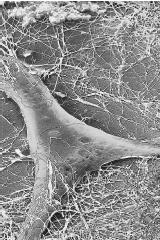Collagen
Collagen is a family of proteins; in animals these proteins play critical roles in tissue architecture, tissue strength, and cell to cell relationships. The major component of all connective tissue matrixes, collagen is found in tissues such as skin, blood vessels, bone, tendon, and ligament, and is characterized by tremendous strength.

The word "collagen" derives from the Greek word for "glue"; this derivation is based on the observation that insoluble collagen, when heated in water, becomes soluble, gummy gelatin that can be used in the manufacture of glues or as a thickener in foods. There are ten known forms of collagen that, because of differences in functional requirements and chemical environments, differ in some details of composition. All forms of collagen share the same basic structure: three polypeptide chains coiled together to form a triple helix . (These triple coils, in turn, become coiled together.) Collagen polypeptide chains generally contain around 1,000 amino acids.
An individual collagen polypeptide chain has a large number of repeating amino acid sequences, most often glycine–X–Y, where X is often proline and Y is often hydroxyproline. Lysine, in its pure form or modified to hydroxylysine, is also found in collagen. Both hydroxyproline and hydroxylysine are formed via the enzyme-catalyzed oxidations of the proline and lysine amino acid side chains, which occur after the collagen polypeptide has been synthesized. These enzymatic reactions require ascorbic acid ( vitamin C) as a cofactor .
Individual collagen polypeptides form an extended, left-handed triple helix, which is longer and less compact than the α -helixes often seen in proteins. Three of these helixes then form a molecule of tropocollagen , the basic building block of collagen, by coiling around a central axis in a right-handed, triple-helical arrangement. The side chain of every third amino acid is very close to the central axis of this superhelix . Glycine, with the smallest side chain of any amino acid, is more easily accommodated in these arrangements than the larger, bulkier amino acids.
Tropocollagen molecules associate in a staggered fashion to form collagen fibrils , which are stronger than steel wire of similar size. Collagen fibrils are strengthened and stabilized mainly by covalent cross-links, existing both within and between individual tropocollagen molecules. These crosslinks represent the enzyme-catalyzed formation of covalent bonds involving lysine and hydroxylysine side chains. The extent of cross-linking depends on the specific function of the collagen molecule involved and the age of the animal; older animals have more highly cross-linked and therefore more rigid collagen.
There are a number of collagen-related disorders that have been identified. Many of these are the result of derangements in the biosynthesis of collagen. Scurvy, characterized by bleeding gums, loose teeth, skin lesions, and weakened blood vessels, results from severe vitamin C deficiency, which makes it almost impossible for afflicted individuals to form hydroxyproline and hydroxylysine. The conditions, known collectively as the Ehlers–Danlo syndromes, result from defects in the processing of collagen polypeptides.
In addition to its importance in the production of animal glue, collagen is the basis for gelatin, which forms when collagen fibers are denatured as a result of heating and then get tangled up with each other. Collagen is also used for various biomedical applications.
SEE ALSO Denaturation ; Peptide Bond ; Proteins .
Matthew A. Fisher
Bibliography
Branden, Carl, and Tooze, John (1999). Introduction to Protein Structure , 2nd edition. New York: Garland Publishing.
Meyers, Robert A., ed. (1995). Molecular Biology and Biotechnology: A Comprehensive Desk Reference. New York: VCH.
Comment about this article, ask questions, or add new information about this topic: